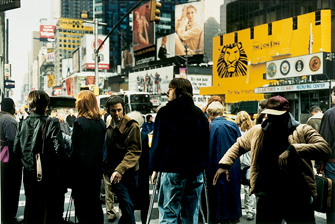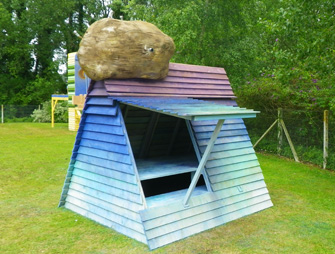 |
|
Mathieu Mercier’s “Cage à Oiseaux.” |
The French city of Nantes is one of the last destinations you would consider for a safari, unless you were on the hunt for works of animal-themed art, currently the …
 |
|
Mathieu Mercier’s “Cage à Oiseaux.” |
Dieppe’s charms are not obvious, and that is precisely the major attraction of this slightly down-at-the-heels northern French seaside resort, battered over the centuries by waves and wars, and colonized sporadically by foreign troops and British holidaymakers. Destroyed by a British-Dutch naval attack in 1694, the Norman city took another big hit in 1942, when some 1,400 Allied invaders lost their lives and nearly 2,000 were captured when they attacked the German-occupied port during the Dieppe Raid.
The city soldiers on, however, with its imposing hilltop château watching benevolently over postwar waterfront construction that may remind some of Soviet public housing, a beach that consists not of fine golden sand but of smooth pebbles (having picnicked on them, I can attest that they make a surprisingly comfortable seat) and a topnotch indoor-outdoor swimming-pool complex. The city’s slight imperfections have the advantage of repelling glamour- and luxury-seeking tourists while attracting those who can appreciate the bracing sea air in this real-life town inhabited by real-life people.
Since last year, a new art festival called Diep, curated by two enterprising young artists, Alice Schÿler Mallet and Philippe Terrier-Hermann, has been helping to put Dieppe back on the art-world map, where it was firmly established in the 19th century when the port town and the nearby cliffs overlooking the English Channel were popular painting perches for no less than Camille Pissarro, Claude Monet, Paul Gauguin, Auguste Renoir, Eugène Boudin, Alfred Sisley, Jacques-Emile Blanche and Eva Gonzalès.
In 2010, the first annual Diep Festival took part in a Normandy-wide celebration of the Impressionists, but this year it is focusing on the area’s Modernist heritage with exhibitions in various sites in and around the city that visitors might otherwise miss.
One example is the Villa Perrotte, a well-preserved Modernist house designed in 1928 by Georges Féray, which stands out on a side street lined with the rather glum-looking traditional dark-red-brick houses. Now a private art gallery, it has been lent to the festival for “Plan Libre,” a show of conceptual works by young artists inspired by the utopian ideals of the Modernist movement and by the house itself, which served first as a residence and then as medical office and still has its original stained-glass windows, wrought-iron fixtures, frosted-glass hanging lamps and built-in furnishings.
Another untouched (but dilapidated) Modernist monument, a classified school building designed by (and named after) Georges Thurin, located in the nearby town of Arques-la-Bataille, serves as the setting for four photography shows. The idea of the four shows is to “take inventory” of the Dieppe area’s architecture today. Maxime Brygo’s faded-color images take a distant, almost cold look at very ordinary buildings, while Valérie Jouve offers monumental color photos of infrastructure projects. Curator Terrier-Hermann has created a series of 26 postcards of the city’s often-overlooked Modernist “monuments,” including a building designed by Le Corbusier that has been kitschified beyond recognition and has even been topped with a peaked roof (blasphemy to a Modernist). The richly textured black-and-white photos of Olivier Mériel are alone worth the short trip to Arques-la-Bataille for this show; my favorite was a long exposure of the interior of an empty barbershop with Dieppe’s famous Pont Colbert seen through a window and reflected in a mirror.
The tables have been turned at the 15th-century Château-Musée de Dieppe, home to a wonderfully unrestored provincial museum full of maritime and artistic treasures, among them many fine examples of carved ivory and Impressionist paintings. Instead of exhibiting artworks in a Modernist setting, the curators have slipped contemporary works (from the Fonds Régional d’Art Contemporain Haute-Normandie, one of France’s network of government-sponsored regional contemporary art centers) in among the museum’s permanent collection, juxtaposing, for example, two different concepts of urban “modernity”: Karin Apollonia Müller’s 1997 photo of crisscrossing highway ramps in Los Angeles and Gustave Loiseau’s painting of crowds on the streets of Paris on Bastille Day in 1926.
More works from the FRAC are on show in the seaside Espace de la Mer cultural center in
 |
|
“New York” (1998) by Philip-Lorca diCorcia. |
Pourville-sur-Mer, a favorite painting site for the Impressionists, where the theme is the “banality of everyday life,” with installations and photographs, notably Philip-Lorca diCorcia’s stop-action images of crowded New York City streets.
Everyday life becomes anything but banal in the festival’s “Châteaux Secrets” project. The organizers invited six groups of artists to take inspiration from Le Corbusier’s Le Cabanon – a shack he built in Roquebrune Cap-Martin to use as a retreat and referred to as his Côte d’Azur “castle” – and build their own castles on a campground by a lake in Arques-la-Bataille. The sometimes wacky, sometimes poetic results – a stairway to heaven, a platform for watching the stars from a hammock, a wooden tent complete
 |
|
“La Villa Parmentier” by Florence Doléac and David de Tscharner, who followed Le Corbusier’s advice to use a potato to deflect lightning from a tent. |
with side flaps that open and a (fake) potato to deflect lightning – can actually be rented by anyone this summer for only €5 a night (reserve now at 06 69 03 31 61 or diepfestival@gmail.com).
The campground is located right next to one of the few remaining “Tournesol” swimming pools in France. Over 180 of these highly modern spaceship-shaped pools designed by architect Bernard Schoeller were produced in the early 1970s by the government to encourage the practice of sports by supplying easy-to-manufacture equipment, but sadly most of them have now gone the way of the space shuttle.
The festival provides yet another good reason for visiting Dieppe, which also hosts an
 |
|
The next International Kite Festival will be held in Dieppe in September 2012. |
international kite-flying festival every two years (the next one will be held in September 2012), a colorful sight.
Diep Festival sites: Villa Perrotte: 9 rue Jules Ferry, 76200 Dieppe. Groupe Scolaire Georges Thurin: Place Léon Baudelot, 76880 Arques-la-Bataille. Château-Musée: rue de Chastes, 76200 Dieppe. Espace de la Mer: Place du Casino, 76550 Pourville-sur-Mer. Campground: Les Etangs d’Arques-la-Bataille. Tel.: 06 69 03 31 61. Reservations: diepfestival@gmail.com). Exhibitions and campground open to visitors Wednesday-Sunday, 2pm-6pm. Through August 21. Festival pass (catalogue included): €3. www.diepfestival.blogspot.com
Reader Reaction: Click here to respond to this article (your response may be published on this page and is subject to editing).
Please support Paris Update by ordering books from Paris Update’s Amazon store at no extra cost. Click on your preferred Amazon location: U.K., France, U.S.
© 2011 Paris Update
